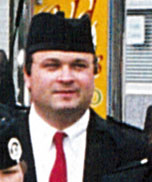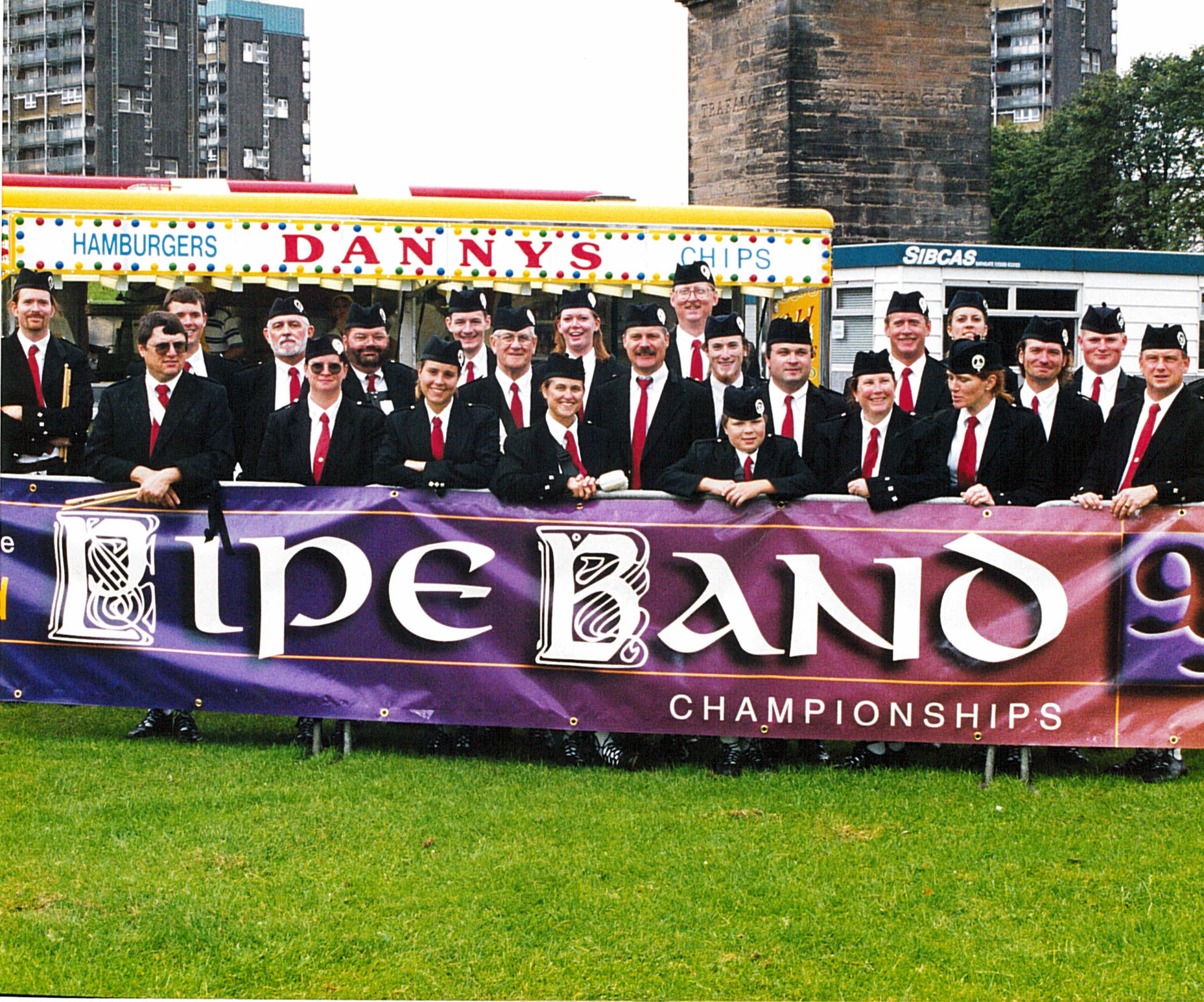By Siraj Asfahani | November 13, 2012
This blog post is not my usual, straight-laced update posting on Lakota projects and happenings. Nope, it’s not even my customary musings about some cool, forlorn old buildings I happened to come across during a work assignment. This time around, I thought I’d write about my quirky but somewhat intriguing (to some) little hobby, one that I’ve enjoyed for practically my entire life. And nope, it’s not my obsessive pursuit for that perfect dram of the “water of life,” (that’s whiskey in Gaelic, a subject for some future post), although it’s somewhat closely related.
Yep, I thought I’d write about my life and times playing the Great Highland Bagpipe. You know, that instrument that we all love (or hate) to see and hear during weddings, funerals and those occasional parades in our communities. Many curious minds — friends, colleagues, clients, relatives, Green Line riders — have always asked me how a person with a long Greek surname got involved with playing such an instrument. But I’m sure your first question is why in heaven’s sake am I taking up space on this company blog to write about a personal hobby? How does that relate at all to preservation, planning and design? I’ll get to the connection shortly.
But before that, let’s talk some history. I’ve been playing the bagpipes since I was a young lad growing up in Elmhurst, Illinois, one of Chicago’s western suburbs. In my last year of schooling before entering high school, my father happened to come across a couple of tickets to see the Black Watch in concert at the old Chicago Stadium, the original “Madhouse on Madison” where the Chicago Bulls and Blackhawks played before it was torn down for the new United Center in the 1990s. You ask, “What is the Black Watch?” The Black Watch is the name given to the senior Scottish regiment in the British Army formed in the early 1740s to “watch” over the Highlands after several clans had revolted from the British crown. Anyhow, my father and I attended the concert, which showcased the regiment’s pipe and drum corps along with the band of another British regiment, the Scot Guards.
Needless to say, it was quite an extraordinary show of British military music, marching precision and storytelling. Each set of music played during the concert strived to narrate some aspect of the regiment’s illustrious history and its many battle honors won over the course of three centuries. Of course, I was enthralled by the Black Watch’s pipes and drums corps, especially the bagpipes and that very powerful but ancient sound. For something that I’ve never heard it before it just captivated me. Their crisp, colorful kilts and military tunics and epaulets were also just way too cool. Okay, I was hooked –I must learn how to play that instrument! I told my dad a few days later about my desire to learn the bagpipes. I remember that blank stare he first had and then his words, “Greek American kids don’t play the bagpipes!” He later admitted he kind of liked the music too and relented. He would also tell me in later years, “You know, if I recall, I think the Greeks invented the bagpipes, too.”
So, that’s how my bagpipe journey started. During my high school years, while my friends were preoccupied with schoolwork and sports, and listening to the music of the Rush, AC-DC and Madonna (aging myself there), I spent most of my spare time studying the bagpipes and listening to what pipe band music I could get my hands on. I did start taking lessons from a gruff by very talented Scottish émigré who settled in Chicago after once playing pipes with another famous Scottish regiment, the Gordon Highlanders. His Scottish accent was pretty thick and difficult to understand at times but he was an excellent instructor. He always told me that practice and hard work has to go into the pipes since it’s quite an unforgiving instrument. “If you don’t,” he said, “people will think you have kept a blind squealing pig underneath your arm all this time.”
By the time I entered junior year in high school, I finally purchased my first set of bagpipes after spending a couple of years learning on the “practice chanter”, a smaller recorder type instrument meant to hone your playing technique before you ever touch the bagpipes. I bought my set from Gillanders and McLeod in Edinburgh, Scotland, one of the more well-known bagpipe makers out there after saving $600 from cutting neighbors’ lawns and cleaning out my dad’s office on Friday nights. I guess my father knew there would be some benefit to him in encouraging me to play. After wiring my order and the money overseas to Gillanders, I couldn’t wait for it to arrive. When it did, I was like Ralphie when he received his Red Ryder B.B. gun in the Christmas Story–I could not wait to put it together and play it all day long. Of course, thankfully for my family, no one had yet taught me how to blow the thing up yet.
Since then, once I had learned to play the bagpipes, it provided me with some of the most wonderful, memorable adventures of my life. I continued my private lessons all the way through my college and graduate school days, but later, in the 1990s, I joined the University of Chicago Pipe Band, which had been up until that time one of the Chicago area’s best pipe bands. The band had usually played for a variety of university events and graduation ceremonies, but had also spent its summers traveling through the Midwest Highland games circuit. Yes, like the big kilted guys who toss big telephone poles (cabers for the highbrows out there) and the border collies that chase sheep around a pen, there are competition events at Highland games strictly for piper soloists and pipe bands. Bands vie against each other by playing sets of bagpipe music consisting of a medley of marches, strathpeys, reels, hornpipes, slow airs and jigs, and those that play the music together with few note errors and some sense of musicality, would garner the top prizes. But even if you didn’t figure in the prize list, there was always the after-competition beer tent, which always afforded the opportunity to commiserate with your fellow pipers on a poor showing. Frankly, the beer tent was always the highlight of the games. However, once the games were done for the day, you usually wound up very tired.
Over the years, I’ve had the good fortune to travel to many places with the University and play in various games in Canada and to Glasgow, Scotland for the World Pipe Band Championships. Now that is an event unlike any other. More than 8,000 pipers and drummers gather for one day in mid-August to play for the most coveted prize in the pipe band world. If you attend the World’s, you’re also guaranteed to get a “ringing ear” –meaning that you will be hearing bagpipes in your brain for at least one or two days after the event. Beyond the travels, I’ve also had the chance to play for several luminaries and VIPs, including Mayor Richie Daley during a St. Patty Day event and President Bill Clinton when he was a commencement speaker for the U. of C. one year. I remember that latter occasion very much since my pipes were placed through a metal detector and inspected by the Secret Service.
Five years ago, I returned to Scotland and the Gillanders and McLeod workshop to have my pipes refitted with hand-chased silver ornaments, which added a bit of well-earned elegance to a set of pipes that have been with me through thick and thin for more than 25 years. Amazingly, the craftsman who first made my pipes way back when was still there and was just geeked at the chance to add the silver trimmings. The new ornaments, however, did add a bit of weight to the pipes and my back muscles tense up bit after playing. All in all, despite the back aches, they have become a very prized possession.
Today, even though I do not spend as much time playing the Highland games circuit during the summer as I used to, I’m still quite excited doing gigs with my fellow pipe band mates — parades, weddings, bar gigs, dances, an Irish wake every so often. Occasionally, I’m invited to play the opening ceremonies for one of the many annual curling tournaments in the Chicago area. Curling tournaments may sound like fun but playing the pipes in full band regalia while walking on a sheet of ice is not that easy.
After years of pursuing this avocation, I have come to appreciate how bagpiping has helped me become a better person. Those years of constant practice needed to compete in pipe band competitions have not only helped me develop a good work ethic but also a clear understanding of the team work that’s necessary for achieving success. A pipe band performs well when every piper is playing the same notes and following the beat. Any one piper who plays the wrong note or is out of rhythm with the rest usually means you’re out of the prize money and receiving an early invitation to the beer tent. I’ve always thought that good team work and community cooperation are the essential ingredients to saving buildings and revitalizing downtowns and neighborhoods. When everyone in the community is involved and seeing the same vision, much can get accomplished. There’s an ancient Scottish proverb that says, “Twelve highlanders and bagpipe make a rebellion.” To me, a few good, committed people are all it takes to change a community.
Well, that’s the end to this post. Come see me soon at a Highland games, in the beer tent.


